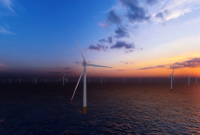Thank you for helping us meet our fundraising goal!
All the dry stats about climate change can obscure a more fundamental truth: We are fools to court the violence of nature.
It’s one thing to learn that the air holds more moisture as it gets hotter. You may have heard the factoid that the atmosphere holds seven per cent more water vapour for every degree of temperature rise.
That’s the basic thermodynamics. Doesn’t sound like such a big deal. Unless you’re underneath the sky when it spins that moisture together and disgorges it from the heavens.
The sheer volume of water dumped by Hurricane Helene was beyond comprehension. People are doing their best to make sense of it: something like 42 trillion gallons of water fell from the sky (160 trillion litres, if that’s any more fathomable to you).
It’s so much water that North Carolina would have been over 1 metre (3.5 feet) deep had it all landed in that one state, according to the Associated Press. Over 60 million Olympic-sized pools, as its reporter gamely tried to convey — but when we’re talking about tens of millions of anything, our minds still fail.
Another attempt at the math that does begin to register: imagine the torrent over Niagara Falls for 619 days, all landing in a matter of hours.
“An astronomical amount of precipitation,” said the head of the National Water Center at the U.S. National Oceanic and Atmospheric Administration, reaching to outer space for adjectives. “I have not seen something in my 25 years of working at the weather service that is this geographically large of an extent and the sheer volume of water that fell from the sky.’'
One observation point reported three feet of rain at Jonas Ridge, North Carolina. Spread among the wind and water, Accuweather reported 33 tornadoes.
As Helene approached landfall, its northern eye wall generated more than 5,000 lightning strikes… in a single hour. It transformed into a monster, undergoing “rapid intensification,” because of the record hot water in the Gulf of Mexico. Another casualty of those laws of thermodynamics — storms feed off water temperatures. We’ve always had storms but hotter water makes storms into superstorms. Helene hit Florida with windspeeds up to 225 km/h.
In the past eight years, as many massive hurricanes (Category four or five) have hit the U.S. as there were in the previous 57 years.
Helene was still at hurricane strength even 300 kilometres from the coast, well after the point where a hurricane normally loses enough steam to become a tropical storm. And its violence continued much further still. Large swaths of Asheville, North Carolina were inundated, submerged nearly 8 metres deep, as cascades tore down mountainsides and the French Broad River burst into the city.
Climate change made this mind-boggling amount of rainfall “up to 20 times more likely,” according to the first attribution studies, carried out by Lawrence Berkeley National Laboratory. The scientists say their “best estimate is that climate change may have caused as much as 50 per cent more rainfall in some parts of Georgia and the Carolinas.”
Offshore, the hot ocean water that fuelled Helene’s intensification was 300 to 500 times more likely because of global heating, according to estimates from Climate Central’s Shift Index.
These rapid attribution studies may be new but they are backed up by the very fossil fuel companies that deserve attribution for this violent new climate. And that corroboration is not new at all. Big Oil has been anticipating big extremes driven by seemingly small shifts for a long time. As far back in 1989, Shell’s “Planning Scenarios” warned that one degree in temperature or a few percentage points in moisture content would be catastrophic:
“These seem small changes but they mask more dramatic temperature changes… There would be more violent weather — more storms, more droughts, more deluges.” Our new violent weather is playing out just as the planning scenarios envisaged. But the planners had a longer horizon while they chose to fund climate denial instead of sounding alarm bells. Imagine burying this assessment of your business model in the archives: “Boundaries would count for little. Conflicts would abound. Civilisation could prove a fragile thing.”
Drowning in costs
The death toll from Helene is still rising but it will be the most deadly after Hurricane Katrina. Social media has itself been flooded with grisly video of caskets washing down raging rivers, along with cell phone snippets of homes, bridges and, the now-ubiquitous tumbling of cars, trucks and RVs.
Those who survive the flood are likely to be drowning in costs. A tiny fraction of households had flood insurance. Less than one per cent in Swannanoa, North Carolina which was “completely and entirely erased.” The Federal Emergency Management Agency says the figure is less than four per cent across the country and, on Wednesday, warned it does not have enough funding to make it through the hurricane season.
But our newsfeeds are so US-centric that we should make a point of panning out. Just as Helene was storming into Florida, Hurricane John hit the west coast of Mexico. John unleashed almost a metre (95 cm) of rain onto Acapulco and surrounding areas, still-recovering from Hurricane Otis one year ago. The same weekend, more than 200 people were killed by flooding in and around Kathmandu.
The list of major floods is, itself, hard to grasp. If you have the stomach for it, several social media accounts now try to track the global situation, some more focused on storms and floods and others on extreme temperatures. Violent flooding has hit Japan, Chad, the Philippines, Spain, Central Europe, India, Guatemala, Nigeria, Thailand, Greece, Taiwan, and China, just in the past few weeks. The news cycle churns so quickly that much of the world barely remembers the floods in 2022 that submerged one-third of Pakistan. Or the April floods in Brazil that swept in so quickly that, in addition to the fatalities, an incredible 150,000 people were injured, leaving 80,000 displaced. Not even one month ago, flooding in West and Central Africa “left millions in dire need of assistance” — hundreds of thousands of hectares of farmland was “wiped out,” according to the International Federation of Red Cross and Red Crescent. That organization has established its own Climate Centre which says: “The floods are testament to climate crisis damage in Africa and how it's affecting vulnerable communities.”
A climate haven
The deadly flooding of Asheville has a particularly sobering dimension. The city had gained a reputation as a “climate haven.” Up in the temperate Blue Ridge mountains, it’s a fast-growing city, largely because of newcomers seeking climate safety.
News reports and headlines like “Come Hell Or High Water, Asheville is Climate Winner,” had become a bit of a sub-genre. In its coverage of climate migration, the New York Times profiled a retired couple who moved to the city after evacuating eight times in Florida (from hurricanes) and California (from fires).
And it wasn’t only regular citizens doing their own research. Asheville “likely has more scientists working on climate change per capita than any other town or city in America,” says Edward Maibach, director of the Center for Climate Change Communication at George Mason University. The city is home to the world’s largest archive of data on climate and extreme weather — the National Climatic Data Center. It was knocked offline by Helene.
As the floodwaters began to recede, the “climate haven” subgenre turned on itself. “Hurricane Helene inflicts the ‘ultimate irony’ on North Carolina climate city,” CNN reported. Other headlines were more blunt: “Nowhere is safe,” thundered The Guardian. The business magazine Fast Company declared: “Asheville has been called a ‘climate haven.’ There’s no such thing.”
The story of climate change has typically been dominated by the language of temperature. Heat, drought and fire are the most obvious effects, along with the creeping threat of melting ice and rising seas. But it’s ever more obvious that the astounding power of water will be a central force. The language of hundred-year floods or thousand-year floods has become nonsense in this fossil-fuelled climate.
Those planners at Shell knew it would become nonsense decades ago. As did the planners at fossil fuel companies worldwide. They, and their political proxies, have spent those precious decades fostering denial and delay. “We” get hit by the deluge. But it is not the grand “we” who have courted the violence of nature.






Comments
These events are just a « Chinese hoax »!!!
Just wait until hurricane Milton (currently a cat 3) dumbs it load of rain and destruction on Florida. Just in time after a major insurers issued cancellations and will not renew notices to 600K policy holders.